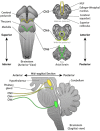A window into eye movement dysfunction following mTBI: A scoping review of magnetic resonance imaging and eye tracking findings
- PMID: 35861623
- PMCID: PMC9392543
- DOI: 10.1002/brb3.2714
A window into eye movement dysfunction following mTBI: A scoping review of magnetic resonance imaging and eye tracking findings
Abstract
Mild traumatic brain injury (mTBI), commonly known as concussion, is a complex neurobehavioral phenomenon affecting six in 1000 people globally each year. Symptoms last between days and years as microstructural damage to axons and neurometabolic changes result in brain network disruption. There is no clinically available objective biomarker to diagnose the severity of injury or monitor recovery. However, emerging evidence suggests eye movement dysfunction (e.g., saccades and smooth pursuits) in patients with mTBI. Patients with a higher symptom burden and prolonged recovery time following injury may show higher degrees of eye movement dysfunction. Likewise, recent advances in magnetic resonance imaging (MRI) have revealed both white matter tract damage and functional network alterations in mTBI patients, which involve areas responsible for the ocular motor control. This scoping review is presented in three sections: Section 1 explores the anatomical control of eye movements to aid the reader with interpreting the discussion in subsequent sections. Section 2 examines the relationship between abnormal MRI findings and eye tracking after mTBI based on the available evidence. Finally, Section 3 communicates gaps in our knowledge about MRI and eye tracking, which should be addressed in order to substantiate this emerging field.
Keywords: DTI; MRI; concussion; eye tracking; fMRI; mTBI; ocular motor; oculomotor; saccades; smooth pursuit; white matter tracts.
© 2022 The Authors. Brain and Behavior published by Wiley Periodicals LLC.
Conflict of interest statement
The authors declare that there is no conflict of interest.
Figures














References
-
- Asken, B. M. , DeKosky, S. T. , Clugston, J. R. , Jaffee, M. S. , & Bauer, R. M. (2018). Diffusion tensor imaging (DTI) findings in adult civilian, military, and sport‐related mild traumatic brain injury (mTBI): A systematic critical review. Brain Imaging and Behavior, 12(2), 585–612. 10.1007/s11682-017-9708-9 - DOI - PubMed
-
- Astafiev, S. V. , Shulman, G. L. , Metcalf, N. V. , Rengachary, J. , MacDonald, C. L. , Harrington, D. L. , & Corbetta, M. (2015). Abnormal white matter blood‐oxygen‐level‐dependent signals in chronic mild traumatic brain injury. Journal of Neurotrauma, 32(16), 1254–1271. 10.1089/neu.2014.3547 - DOI - PMC - PubMed
Publication types
MeSH terms
LinkOut - more resources
Full Text Sources
Medical

